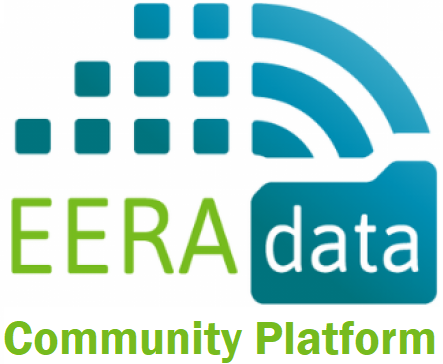With 40% of total energy consumption, buildings are major consumers of energy causing 36% of the total CO2 emissions. Thereby, the building sector has a large untapped potential for the reduction of CO2 emissions by optimizing in construction and management. The EU has issued a Directive on the Energy Performance of Buildings (EPBD) as the main EU policy instrument to improve in this regard (Directive 2002/91/EC). The directive involves a framework for assessing the energy performance of buildings through Energy Performance Certificates (EPCs) that need to include reference values, such as current legal standards. Hence, the relationship between buildings and energy, impacts a wide spectrum from strategic to operational concerns, including energy efficiency investment decisions, buildings energy performance management, energy efficiency policies, smart buildings, and energy disaggregation. This makes data on energy efficiency in buildings crucial for the discussion and the decision-making in many practical contexts by households, academicians, or policymakers. Moreover, a wide variety of information is needed, starting from the existing building stock to solutions in ventilation and air conditioning, socio-demographic information, cultural perception of thermal comfort to climatic and weather information. To some extent, this data is available; however, databases are unorganized and not interlinked. A comprehensive collection of European buildings and urban stock data has been identified by the European Buildings Stock Observatory, serving as a starting point for the use case.
A specific part of energy consumption in residential buildings is due to the use of household appliances. Time series of corresponding demand profiles on this scale are typically not open, but constitute business assets of utilities. A wealth of information on such data is produced due to the massive rollout of smart meters across Europe. Access to this data raises important concerns regarding privacy issues (Véliz and Grunewald 2018). Thus, legal restrictions as well as commercial interests have to be accounted for. Finally, analyzing this information by e.g. geolocation or social strata is key to mitigate energy poverty making the energy transition inclusive for all.
To this end, the use case on buildings efficiency has three main goals: 1) identifying the available metadata on buildings efficiency and constructing a metadata repository of available data, 2) assessing the level of FAIRness and openness of the available data with the contribution of experts from the field in the planned workshops, and 3) contributing to the FAIRification and opening of the available data respecting privacy concerns. In doing so, it will utilize existing databases such as the European Buildings Stock Observatory and the databases developed by the ENTRANZE project. Data regarding energy poverty are collected at the EU Energy Poverty Observatory.
This use case will focus on the metadata assessments of EU Building Stock Observatory, Global Buildings Performance Network (GBPN), Pan-European Thermal Atlas (Peta) v4, Hotmaps to analyze further.
| Name of database | Type of metadata provided | Extend of metadata provided | Level of implementation of FAIR/O principles | Frameworks for metadata used | Technical implementation of metadata |
|---|---|---|---|---|---|
| EU Building Stock Observatory | Provenance (sources), descriptive (axis and time series descriptions), partially provenance (only sources) | Descriptions, definitions, factsheet. However loosely attached to the data itself | F1: Yes, F2: Yes, F3: Yes, F4: No A1: Yes, A1.1: Yes, A1.2: Yes, A2: No I1: Yes, I2: Yes, I3: No R1: Yes, R1.1: No, R1.2: Yes, R1.3: No | Controlled vocabulary and thesaurus | Plain text and html |
| Global Buildings Performance Network (GBPN) | Mostly descriptive, partially provenance (only sources) and administrative (copyright and ownership) | For the graphs regarding comparison of variables for countries/BEECs or multiple variables, sources of data are always listed under the graph. There is also data regarding the descriptions of the BEECs, however, these are more of a plain-text descriptive format and contain almost no metadata. Other than these, there are no other metadata attached. | F1: Yes, F2: Yes, F3: No, F4: No A1: No, A1.1: Yes, A1.2: Yes, A2: No I1: Yes, I2: Yes, I3: No R1: Yes, R1.1: No, R1.2: No, R1.3: No | Mainly controlled vocabulary | Plain text and html |
| Pan-European Thermal Atlas (Peta) v4 | Mostly descriptive, sources (not totally sufficient to trace back to the source) | Metadata contains rich descriptive information and sources | F1: Yes, F2: Yes, F3: Yes, F4: No A1: Yes, A1.1: Yes, A1.2: No, A2: No I1: Yes, I2: Yes, I3: No R1: Yes, R1.1: No, R1.2: Yes, R1.3: No | Controlled vocabulary, taxonomy, and thesaurus | html and plain text |
| ExCEED – European Energy Efficient building district Database | Provenance (Sources), descriptive, type, units , definition | Metadata contains rich descriptive information and sources | F1: YES; F2: YES; F3: YES A1.1: YES; A1.2: YES; I1.: YES I3: YES R1.2: YES | Controlled vocabulary, and thesaurus | html and plain text |
| Hotmaps | Descriptive (name, title, description, version, date, profile, keywords, license), sources (adress and contributors), resources (description of data in more detail, temporal, schema, datatype), unique id | Detailled description of dataset, how it was created and sources. The level of detail is different for each dataset, basic description exists for each one. | F1: Yes, F2: Yes, F3: Yes, F4: No, A1: Yes, A1.1: Yes, A1.2: No, A2: Yes, I1: Yes, I2: Yes, I3: No, R1: Yes, R1.1: Yes, R1.2: Yes, R1.3: No | Controlled Vicabulary | Machine-readable JSON |
